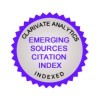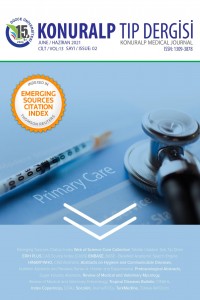Abstract
Amaç: Ortoreksiya Nervosa yeni bir yeme bozukluğudur ve yenen yiyeceklerin kalitesinin aşırı kontrolü olarak bilinir. Doğum sonrası dönemde fizyolojik ve tıbbi değişikliklere bağlı olarak kadınların çoğunun beden imajıyla ilgili endişeleri olduğu ve bu nedenle yaşam tarzlarını değiştirme eğiliminde oldukları ve anneleri Ortoreksiya Nervozaya yönlendirebileceği belirtildi. Bu çalışmanın amacı, postpartum kadınların Ortoreksiya Nervosa eğilimlerini değerlendirmek ve ilgili faktörleri araştırmaktır.
Yöntem: Bu tanımlayıcı araştırma, 1 Aralık 2018-1 Şubat 2019 tarihleri arasında postpartum kadınlarda gerçekleştirildi. Çalışma zamanında 10.350 üyesi olan doğum sonrası kadınlara özel bir sosyal medya grubu aracılığıyla kadınlarla e-posta yoluyla iletişime geçtik. Evren için minimum örneklem büyüklüğü, %95 güven aralığı ve % 5 örnekleme hatası varsayılarak 370 kadın olarak tahmin edilmiştir. Anket iki bölümden oluşmaktadır: katılımcıların genel özellikleri ve ORTO-11 anketi.
Bulgular: Tüm katılımcıların (N=511) ortalama ORTO-11 ölçek puanı 22.68 ± 4.09 (min=12; maks= 35) olup; yaş, çalışma durumu, meslek, aile tipi, sağlıklı olma anlayışı, fiziksel aktivite, diyet durumu ve beslenme sıklığı ile istatistiksel olarak anlamlı ilişki bulundu. Kesim noktasına göre, katılımcıların % 87,7'sinin (n = 426) Orthorexia Nervosa gelişme riski taşıdığı görüldü.
Sonuç: Doğum sonrası dönemde annelerde ON eğilimi yüksek olarak bulundu. Ayrıca doğumdan sonra beslenme alışkanlıklarını ve fiziksel aktivite durumunu değiştiren annelerin ON eğiliminin diğerlerine göre daha yüksek olduğu görüldü. Bu nedenle doğum sonrası dönem, değişen yaşam tarzı alışkanlıkları nedeniyle annelerin ON ve benzeri yeme bozukluklarının yakın takibi açısından çok önemlidir. Aile hekimleri koruyucu hekimlik vasfı ile bu konuda çok kritik bir role sahiptirler.
Supporting Institution
Bulunmamaktadır
Thanks
Bulunmamaktadır.
References
- 1. Brytek-Matera A. Orthorexia nervosa – an eating disorder, obsessive – compulsive disorder or disturbed eating habit? Arch. Psychiatr Psych. 2012;1:55–60.
- 2. Dunn TM, Gibbs J, Whitney N, Starosta A. prevalence of orthorexia nervosa is less than 1%: data from a US sample. Eat Weight Disord. 2017;22(1):185–92.
- 3. Donini L, Marsili D, Graziani M, Imbriale M, Cannella C. Orthorexia nervosa:validation of a diagnosis questionnaire. Eat Weight Disord ST. 2005;10:e28–e32.
- 4. Arusoğlu G, Kabakçı E, Köksal G, Merdol TK. Orthorexia Nervosa and adaptation of ORTO-11 in Turkish. Turk Psikiyatri Derg.2008;19(3):1-9.
- 5. Ramacciotti C, Perrone P, Coli E, Burgalassi A, Conversano C, Massimetti G et al. Orthorexia nervosa in the general population: a preliminary screening using a self-administered questionnaire (ORTO-15). Eat Weight Disord ST. 2011; 16:e127–e130.
- 6. Segura-Garcı´a C, Papaianni MC, Caglioti F, Procopio L, Nistico` CG, Bombardiere L et al. Orthorexia nervosa: a frequent eating disordered behavior in athletes. Eat Weight Disord ST. 2012;17:226–23.
- 7. Bosi BAT, Camur D, Guler C. Prevalence of orthorexia nervosa in resident medical doctors in the faculty of medicine (Ankara, Turkey). Appetite. 2007; 9:661–6
- 8. Alvarenga M, Martins M, Sato K, Vargas S, Philippi S, Scagliusi F. Orthorexia nervosa behavior in a sample of Brazilian dietitians assessed by the Portuguese version of ORTO-15. Eat Weight Disord ST 2012;17:e29–e35
- 9. Brytek-Matera A, Krupa M, Poggiogalle E, Donini LM. Adaptation of the ORTHO-15 test to Polish women and men. Eat Weight Disord ST. 2014;19:69–76.
- 10. Meltzer-Brody S, Howard L, Bergink V, et al. Postpartum psychiatric disorders. Nat Rev Dis Primers. 2018;4:18022.
- 11. Silveira ML, Ertel KA, Dole N, Taber LC. The role of body image in prenatal and postpartum depression: a critical review of the literature. Arch Womens Ment Health. 2015;18(3):409–21.
- 12. Fenercioğlu T, Ayhan Başer D, Kasım İ, Şencan İ, Özkara A. Is There a Relationship between Breastfeeding Status and Lifestyle Changes, Eating Behaviors, Attitudes, and Orthorexia Nervosa tendencies of Mothers? A Web Based Study. International Journal of Clinical Practice. 2021;00:e14098.
- 13. Bzikowska-Jura A, Czerwonogrodzka-Senczyna A, Olędzka G, Szostak-Węgierek D, Weker H, Wesołowska A. maternal nutrition and body composition during breastfeeding: association with human milk composition. nutrients. 2018;10(10):1379.
- 14. Osman H, Zein LE, Wic L. Cultural beliefs that may discourage breastfeeding among Lebanese women: A qualitative analysis. International Breastfeeding Journal. 2009;4(1):12.
- 15. Todd JM, Parnell WR. Nutrient intakes of women who are breastfeeding. Eur J Clin Nut. 1994;48:567-74.
- 16. Nicoll A, Thayaparan B, Newell M, Rundall P. Breast feeding policy, promotion and practice in Europe. Results of a survey with non-governmental organizations. Journal of Nutritional and Environmental Medicine. 2002;12(3):255–64.
- 17. Pak-Gorstein S, HaqElinor A, Graham A. Cultural influences on infant feeding practices. pediatrics in review. 2009;30(3):11-21
- 18. Bratman S, Knight D. Health Food Junkies: Overcoming the obsession with healthful eating. New York. Broadway Boks.2000.
- 19. Fidan T, Ertekin V, Işikay S, Kirpinar I. Prevalence of orthorexia among medical students in Erzurum, Turkey. Comprehensive Psychiatry. 2010;51(1):49–54.
- 20. Missbach B, Hinterbuchinger B, Dreiseitl V, Zellhofer S, Kurz C, König J. When eating right, is measured wrong! A validation and critical examination of the ORTO-15 questionnaire in German. PloS One. 2015;10(8):1.
- 21. Stochel M, Joanna Hyrnik JH, Ireneusz Jelonek IJ, Jan Zejda JZ, Malgorzata Janas-Kozik. Orthorexia among Polish urban youth. European Neuropsychopharmacology. 2013;23(2):527–8.
- 22. Varga M, Thege BK, Dukay-Szabó S, Túry F, Furth EF. When eating healthy is not healthy: orthorexia nervosa and its measurement with the ORTO-15 in Hungary. BMC Psychiatry. 2014;28(14):59.
- 23. Asil E, Sürücüoğlu MS. Orthorexia nervosa in Turkish dietitians. Ecology of Food and Nutrition. 2015; 54(4):303-13.
- 24. Dalmaz M, Yurtdaş GD. Prevalence of orthorexia nervosa symptoms among people who exercise in gyms. Uluslararası Hakemli Ortopedi Travmatoloji ve Spor Hekimliği Dergisi. 2015;4:23-39.
Abstract
Objectives: Orthorexia Nervosa is a new eating disorder and is known as an excessive control of quality of the eaten foods. During postpartum period, related to the physiological and medical changes, it was stated that most of the women have concerns about their body image and therefore they have tendency to change their lifestyle, and it can lead mothers to Orthorexia Nervosa. The aim of this study was to assess the Orthorexia Nervosa tendencies of postpartum women and investigate the related factors.
Methods: This descriptive study was carried out among postpartum women between 1st December 2018-1st February 2019. We contacted with the women via e-mails through a social media group special for postpartum women which had 10.350 members at the time of the study. The minimum sample size for the universe was estimated as 370 women, assuming a 95% confidence interval and 5% sampling error. The questionnaire consists of two parts: the general features of participants and the ORTO-11 questionnaire.
Results: The mean ORTO-11 scale score of all participants (N=511) was 22.68±4.09 (min=12; max=35) and had a statistically significant relationship with age, working status, vocation, family-style, the understanding of being healthy, physical activity, diet status, and the order of nutrition status. According to the cut-off point, 87.7 % (n=426) of the participants were found to be at risk of developing Orthorexia Nervosa.
Conclusions: The tendency toward Orthorexia Nervosa was greater among mothers in the postpartum period. Also the mothers who change their eating habits and change the physical activity status after delivery had higher ON tendency than others. So the postpartum period is very important to follow up the mothers about ON and such eating disorders because of the changing lifestyle habits. Family physicians have a critical role in this regard with their preventive medicine qualifications.
References
- 1. Brytek-Matera A. Orthorexia nervosa – an eating disorder, obsessive – compulsive disorder or disturbed eating habit? Arch. Psychiatr Psych. 2012;1:55–60.
- 2. Dunn TM, Gibbs J, Whitney N, Starosta A. prevalence of orthorexia nervosa is less than 1%: data from a US sample. Eat Weight Disord. 2017;22(1):185–92.
- 3. Donini L, Marsili D, Graziani M, Imbriale M, Cannella C. Orthorexia nervosa:validation of a diagnosis questionnaire. Eat Weight Disord ST. 2005;10:e28–e32.
- 4. Arusoğlu G, Kabakçı E, Köksal G, Merdol TK. Orthorexia Nervosa and adaptation of ORTO-11 in Turkish. Turk Psikiyatri Derg.2008;19(3):1-9.
- 5. Ramacciotti C, Perrone P, Coli E, Burgalassi A, Conversano C, Massimetti G et al. Orthorexia nervosa in the general population: a preliminary screening using a self-administered questionnaire (ORTO-15). Eat Weight Disord ST. 2011; 16:e127–e130.
- 6. Segura-Garcı´a C, Papaianni MC, Caglioti F, Procopio L, Nistico` CG, Bombardiere L et al. Orthorexia nervosa: a frequent eating disordered behavior in athletes. Eat Weight Disord ST. 2012;17:226–23.
- 7. Bosi BAT, Camur D, Guler C. Prevalence of orthorexia nervosa in resident medical doctors in the faculty of medicine (Ankara, Turkey). Appetite. 2007; 9:661–6
- 8. Alvarenga M, Martins M, Sato K, Vargas S, Philippi S, Scagliusi F. Orthorexia nervosa behavior in a sample of Brazilian dietitians assessed by the Portuguese version of ORTO-15. Eat Weight Disord ST 2012;17:e29–e35
- 9. Brytek-Matera A, Krupa M, Poggiogalle E, Donini LM. Adaptation of the ORTHO-15 test to Polish women and men. Eat Weight Disord ST. 2014;19:69–76.
- 10. Meltzer-Brody S, Howard L, Bergink V, et al. Postpartum psychiatric disorders. Nat Rev Dis Primers. 2018;4:18022.
- 11. Silveira ML, Ertel KA, Dole N, Taber LC. The role of body image in prenatal and postpartum depression: a critical review of the literature. Arch Womens Ment Health. 2015;18(3):409–21.
- 12. Fenercioğlu T, Ayhan Başer D, Kasım İ, Şencan İ, Özkara A. Is There a Relationship between Breastfeeding Status and Lifestyle Changes, Eating Behaviors, Attitudes, and Orthorexia Nervosa tendencies of Mothers? A Web Based Study. International Journal of Clinical Practice. 2021;00:e14098.
- 13. Bzikowska-Jura A, Czerwonogrodzka-Senczyna A, Olędzka G, Szostak-Węgierek D, Weker H, Wesołowska A. maternal nutrition and body composition during breastfeeding: association with human milk composition. nutrients. 2018;10(10):1379.
- 14. Osman H, Zein LE, Wic L. Cultural beliefs that may discourage breastfeeding among Lebanese women: A qualitative analysis. International Breastfeeding Journal. 2009;4(1):12.
- 15. Todd JM, Parnell WR. Nutrient intakes of women who are breastfeeding. Eur J Clin Nut. 1994;48:567-74.
- 16. Nicoll A, Thayaparan B, Newell M, Rundall P. Breast feeding policy, promotion and practice in Europe. Results of a survey with non-governmental organizations. Journal of Nutritional and Environmental Medicine. 2002;12(3):255–64.
- 17. Pak-Gorstein S, HaqElinor A, Graham A. Cultural influences on infant feeding practices. pediatrics in review. 2009;30(3):11-21
- 18. Bratman S, Knight D. Health Food Junkies: Overcoming the obsession with healthful eating. New York. Broadway Boks.2000.
- 19. Fidan T, Ertekin V, Işikay S, Kirpinar I. Prevalence of orthorexia among medical students in Erzurum, Turkey. Comprehensive Psychiatry. 2010;51(1):49–54.
- 20. Missbach B, Hinterbuchinger B, Dreiseitl V, Zellhofer S, Kurz C, König J. When eating right, is measured wrong! A validation and critical examination of the ORTO-15 questionnaire in German. PloS One. 2015;10(8):1.
- 21. Stochel M, Joanna Hyrnik JH, Ireneusz Jelonek IJ, Jan Zejda JZ, Malgorzata Janas-Kozik. Orthorexia among Polish urban youth. European Neuropsychopharmacology. 2013;23(2):527–8.
- 22. Varga M, Thege BK, Dukay-Szabó S, Túry F, Furth EF. When eating healthy is not healthy: orthorexia nervosa and its measurement with the ORTO-15 in Hungary. BMC Psychiatry. 2014;28(14):59.
- 23. Asil E, Sürücüoğlu MS. Orthorexia nervosa in Turkish dietitians. Ecology of Food and Nutrition. 2015; 54(4):303-13.
- 24. Dalmaz M, Yurtdaş GD. Prevalence of orthorexia nervosa symptoms among people who exercise in gyms. Uluslararası Hakemli Ortopedi Travmatoloji ve Spor Hekimliği Dergisi. 2015;4:23-39.
Details
| Primary Language | English |
|---|---|
| Subjects | Health Care Administration |
| Journal Section | Articles |
| Authors | |
| Publication Date | June 7, 2021 |
| Acceptance Date | May 9, 2021 |
| Published in Issue | Year 2021 Volume: 13 Issue: 2 |
Cite





